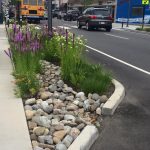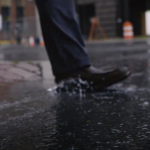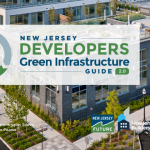New Jersey Future Blog
It’s Official: NJDEP Amends State Stormwater Rules to Require Green Infrastructure
March 11th, 2020 by Louise Wilson
In a welcome and important step forward, long-awaited amendments to New Jersey’s stormwater management rules were published in the March 2, 2020 New Jersey Register. The new rule amendments, which take full effect March 2, 2021, require the use of green infrastructure. Green infrastructure refers to a set of stormwater management practices that use or mimic the natural water cycle to capture, filter, absorb and/or re-use stormwater. Access the newly codified Stormwater Management Rules and NJDEP’s FAQ page.
This rule change signals a paradigm shift in New Jersey stormwater management. It replaces a subjective performance standard with an objective standard, and requires that stormwater management features be distributed around a site rather than centralized in one big basin.
What’s the big deal? Stormwater is a big problem, made increasingly worse by climate change and its weather extremes. Stormwater causes flooding and pollutes the streams, lakes and rivers in which we wade, swim, boat and fish. By most estimates, well over 90% of New Jersey’s waterways are polluted. While the new rule does not change underlying standards for water quality, it will result in more stormwater soaking into the earth, and that’s a good thing.
More can and should be done to prevent pollution and reduce flooding. New Jersey Future is working with other stakeholders and NJDEP to formulate additional rule changes aimed at strengthening standards for water quality and stormwater volume control. Meanwhile, we believe the green infrastructure requirement not only will result in more effective stormwater management, but also will confer important societal, public health and economic co-benefits and help communities become more climate resilient.
Interested to know more?
Here are answers to some frequently asked questions:
How do the new stormwater rules differ from the old rules?
The fundamental difference is that the new rules will require decentralized, distributed stormwater management practices that enable stormwater to infiltrate and more closely resemble the natural water cycle. These “best management practices” (BMPs) include vegetated swales, bioretention, green roofs, cisterns, wet ponds, infiltration basins and constructed wetlands.
Here are some specific differences:
- Replaces a subjective performance standard with an objective, math-based standard that requires the use of green infrastructure to meet water quality, quantity, and recharge standards. The rule includes tables showing which green infrastructure BMPs may be used to meet certain standards, and which BMPs may be used only with a variance.
- The water quality standard will apply to “motor vehicle surface” — meaning, paved or unpaved roads, driveways, parking lots, etc. — instead of impervious surface. Consistent with current NJDEP practice, the water quality standard will not apply to impervious surfaces that are not used by vehicles.
- The “major development” definition now includes “creation of one-quarter acre or more of ‘regulated motor vehicle surface’.”
- Water quantity, quality, and groundwater recharge standards must be met in each drainage area on-site (unless they converge before leaving the property).
- A groundwater mounding analysis is required for all infiltration BMPs, not just for recharge.
- A deed notice for stormwater management measures, including green infrastructure, must be recorded and submitted to NJDEP before construction.
- For cities with combined sewer systems (so-called CSS or CSO communities):
- Water quality treatment is required for discharges into combined sewer systems
- Water quantity control is required in tidal areas (except discharges directly into lower reach of major tidal water bodies)
- Community basins, which will allow several properties in a CSS community to use a single large basin for quantity control, are allowed
Consult the amended stormwater rule and the BMP Manual for more detailed information.
Do the published stormwater rule amendments differ at all from what was proposed in December 2018? If so, how?
The rules published on March 2, 2020 are substantively identical to what was proposed in December 2018. The published rules correct a minor typo, and clarify that manufactured treatment devices (MTDs) that meet the definition of green infrastructure may be used without a variance, while MTDs that do not meet the definition of green infrastructure may be used only with a variance.
Does my city or town have to update its stormwater ordinance?
Yes. Every municipality must update its stormwater ordinance to reflect and comply with the new rule language.
Can my local stormwater ordinance impose stricter requirements than are found in the new state stormwater rule?
Yes–local requirements can be stricter in some ways, for certain kinds of projects. In the preamble to its new model stormwater ordinance, NJDEP notes: “Under New Jersey Municipal Separate Storm Sewer System Permits (MS4), the stormwater program may also include Optional Measures (OMs), that prevent or reduce the pollution of the waters of the State. A municipality may choose these stronger or additional measures in order to address local water quality and flooding conditions as well as other environmental and community needs. For example, municipalities may choose to define “major development” with a smaller area of disturbance and/or smaller area of regulated impervious cover or regulated motor vehicle surface; apply stormwater requirements to both major and minor development; and/or require groundwater recharge, when feasible, in urban redevelopment areas.”
Note: these kinds of higher standards can be applied only to nonresidential projects that go before the local planning board or zoning board of adjustment. Residential projects are governed by the Residential Site Improvement Standards (RSIS), which reference the current stormwater rule. Thus, residential projects subject to planning board or zoning board review must meet the state’s minimum standards, no more and no less. That said, some developers are willing to exceed the state’s minimum standards in the interest of environmental protection, return on investment, marketing, and/or other community interests.
Will there be an organized effort to train professionals and practitioners who need to understand green infrastructure?
Yes. NJDEP, Rutgers University, and the Watershed Institute will conduct training for design professionals and for those who construct, inspect and maintain green infrastructure BMPs. In addition, education and training likely will be available through other experts and interested parties — public sector and private sector — including NJ Society of Municipal Engineers, private engineering firms, ASLA-NJ, APA-NJ, and New Jersey Future.
Related Posts
Tags: green infrastructure, new jersey register, new stormwater rules, njdep, stormwater rules
















